VITAMIN-A FORTIFICATION OF VANILLA ICE CREAM USING BEETROOT GREEN PULP
*Shukla Sudha & **Daniel Madhvi
** Lecturer, * M.Sc. Student
**Dept. of Nutrition, Isabella Thoburn College, Lucknow E mail id: madhvidaniel@gmail.com
ABSTRACT
Present study was carried out with the objective to fortify vanilla ice cream with vitamin A using beet root green pulp at different levels of fortification & to assess enhanced nutritional quality of the developed product. A control and four experimental treatments were prepared with varying proportions of beetroot green pulp- 3%, 6%, 9%, and 12%. Organoleptic evaluation of the ice cream was carried out using 9-Point Hedonic scale. The data obtained was analyzed statistically using analysis of variance and critical different techniques. Estimation of vitamin A content of sample showed high improvement in nutritional value of vanilla ice cream with maximum value of 181.72 ìg. There was linear increase in calcium content of the product from 47mg- 59mg .
Keywords: Vitamin-A, Fortification, vanilla ice cream, beetroot green.
INTRODUCTION
Ice cream is defined as “a frozen product that contains not less than 10% milk fat, 3.5% protein, 36.0% total solids, and 0.5% permitted stabilizer and emulsifier” (PFA Rules,1955 ).
Ice cream is palatable, nutritious, healthful, and relatively inexpensive food. One serving of ice cream of average composition 4 fluid ounces, weighs about 70 g, and supplies about 130 calories, 30mg Protein, 100 mg Calcium, 70 mg Phosphorus, 250 IU Vitamin A, 120mg Riboflavin, and 30ìg Thiamine (R. T. Marshall, et al.,1996). It can be fortified with different types of nutrient using various nutritious fruits like Mango, Strawberry and Beetroot as they contain large amount of nutrients.
Beets are a unique source of phytonutrients called betalains. Betanin and vulgaxanthin are the two best-studied betalains from beets, and both have been shown to provide antioxidant, anti-inflammatory, and detoxification support. The detox support provided by betalains includes support of some especially important Phase 2 detox steps involving glutathione.
The bright red colour in beet roots is caused by betacyanin, a water-soluble plant pigment related to anthocyanin. Anthocyanins often have antioxidant properties and are believed to be good for health. Beet roots are good sources of folic acid, potassium and dietary fiber. They also contain sugars that contribute to its calorie content.
OBJECTIVES
To develop a nutritious beet green vanilla ice cream.
To fortify vanilla ice cream with vitamin A using beetroot green pulp.
To evaluate the organoleptic and nutritional quality of developed beet green vanilla ice cream.
METHODOLOGY
Development of Vanilla Ice cream:
This step involved the whole idea of development of beet green vanilla ice cream naturally fortified with vitamin A, present in beetroot green.
Idea Generation
Selection of ingredients
Processing of new product
New product develop
Development of New Product
Preparation of Experiment:
Nutritious beet green vanilla ice cream (50 g) was prepared by using Ice cream mix. Heating of milk at a temperature of 155°F (68.3°C) for 30 minutes or 175°F (79.4C) for 25 second. Now add vanilla extract and the mixture was kept in the refrigerator for 2 hours after that homogenize the mixture with beetroot green pulp at 3%, 6%, 9%, and 12% in different concentration , then stored in an air tight container and freeze for an additional 2 hours.
Treatments:
T1 – Beetroot vanilla ice cream using 3% beetroot green pulp.
T2 - Beetroot vanilla ice cream using 6% beetroot green pulp.
T3 - Beetroot vanilla ice cream using 9% beetroot green pulp.
T4 - Beetroot vanilla ice cream using 12% beetroot green pulp.
Organoleptic evaluation of Ice cream:
The different treatments of beet green vanilla ice cream were prepared and were put forward for the next step of the study i: e, for the sensory evaluation for identifying the best acceptable product. Codes T1, T2, T3, and T4 with different concentrations of beet green 3%, 6%, 9% and 12% respectively. Then a 9 point hedonic scale was prepared.
Preparation of the product
↓
Coding of the developed product
↓
Quality estimation through 9 point hedonic scale
↓
Interpretation of the score card
↓
Evaluation of the best acceptable product
Flow Chart Representing Work Methodology
Nutritional analysis
The next step involved nutritional analysis of the prepared Vanilla ice cream involving different parameters like total energy, fat, protein, calcium, vitamin A & iron percentage.
RESULTS AND DISCUSSION
The sensory evaluation of the fortified vanilla ice-cream was done on the basis of four parameters- Body and Texture, Color and Appearance, Flavor and Taste & Overall Acceptability.
The overall acceptability graph represents the acceptance on the basis of different parameters like body and texture, color, appearance, flavor and taste. The maximum average score is 58 by the product T2 & T4.
GRAPHICAL REPRESENTATION OF SCORES TOO OVERALL ACCEPTIBILITY.
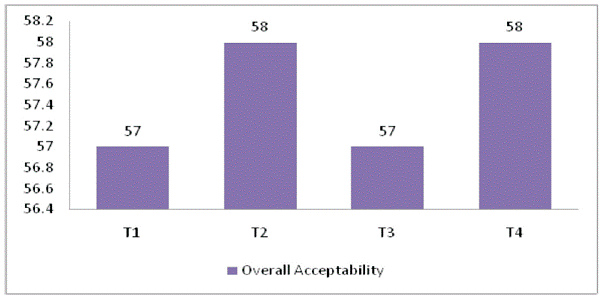
Nutrient Content in Control and Experimental Vanilla Ice Cream
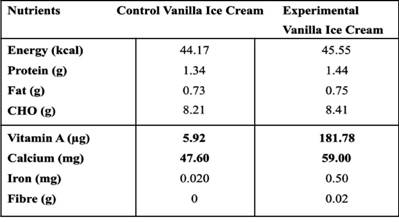
Fig 2- Energy and Vitamin A Content in Control and Experimental Vanilla Ice Cream
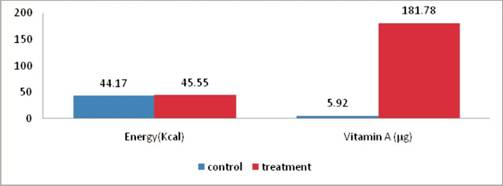
Fig 3- Carbohydrate and Calcium Content in Control and Experimental Vanilla Ice Cream
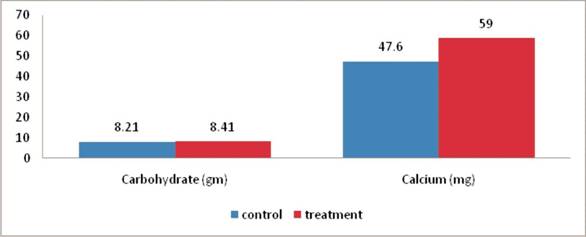
Fig-4 Iron and Fibre Content in Control and Experimental Vanilla Ice Cream
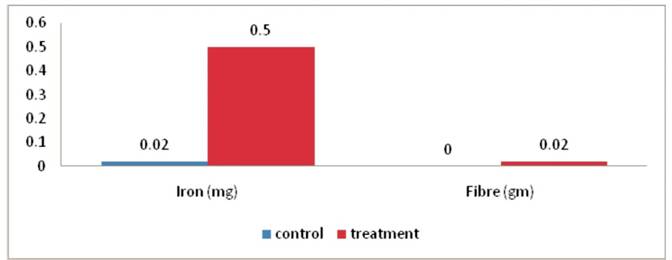
CONCLUSION
The current study was undertaken with the objective of developing vitamin A rich Vanilla ice cream using beetroot green pulp. The process of developing vanilla ice cream involved the use of beetroot green pulp to increase its nutritional value. Plain vanilla ice cream contains less amount of vitamin A and thus beetroot green pulp was used to fortify the vanilla ice cream because of its high vitamin A content. (Busch S, 2013)
After developing the beet green vanilla ice cream nutritional analysis was done and it was compared with the plain vanilla ice cream. Significant increase in the value of vitamin A was observed.
Beet greens are an excellent source of vitamin A that is necessary for good vision, playing a role in light absorption in the rods and cones of retina. An individual also need vitamin A for cell differentiation, immunity and healthy skin. Body uses fat to process and store vitamin A, which remains in the system longer than water soluble vitamins.
The fortified vanilla ice cream also contains a great amount of calcium i.e. 118 mg per 100 gram. Calcium is a mineral that is stored in the bones. Nearly all the calcium in the body is stored in bone tissue. Calcium is an important mineral for bone growth and maintenance, nerve and muscle function, and blood clotting.
The fortified vanilla ice cream shows a significant increase in calcium, and vitamin A content when compared to the plain vanilla ice cream. The analysis of variance was applied to check the significant association between some parameters and treatment so we can say that flavour and taste, colour and appearance and overall acceptability is significant (<0.05). The fortified vanilla ice cream can be used as a substitute or an alternative to the plain vanilla ice cream because of its high nutritional content.
REFERNCES
Busch S., “The Nutritional Content of Beet Leaves”, 2013.
R. T. Marshall and W. S. Arbuckle, “Ice Cream”, 5th Edition., Chapman and Hall, New York, 1996, pp. 1-2.
Article Information
Sr No: 10
Page No: 61-64
Size:
Download:
Cited By:
Language: English
Licence: IJW
Authors: Shukla Sudha* & Daniel Madhvi
Authors Address: ** M.Sc. Student Dept. of Nutrition, Isabella Thoburn College, Lucknow E mail id:
Email: madhvidaniel@gmail.com
Published: 14 November, 2014



